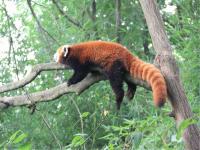
Animals in Jiuzhaigou National Park
Jiuzhaigou National Park, a UNESCO World Heritage site in China, is not only renowned for its stunning landscapes but also for its rich biodiversity. The park provides a sanctuary for a diverse range of animal species, inhabiting its varied ecosystems of forests, grasslands, and wetlands.
Mammal Species
The park is home to over 170 mammal species. This includes 27 state-protected rare and endangered species, some of the most notable being:
| Animal | Scientific Name | Conservation Status | Interesting Fact |
|---|---|---|---|
| Giant Panda | Ailuropoda melanoleuca | Vulnerable | The park forms part of the larger Giant Panda National Park and is a vital habitat for this iconic species. |
| Golden Monkey | Rhinopithecus roxellana | Endangered | These monkeys with their striking golden fur are often spotted in the park's higher altitude forests. |
| White-lipped Deer | Cervus albirostris | Vulnerable | Known for its distinctive white patch around its muzzle, this deer species is endemic to the Tibetan Plateau. |
| Forest Musk Deer | Moschus berezovskii | Endangered | This small deer species is highly valued for its musk gland, leading to significant hunting pressure. |
Other notable mammals found in Jiuzhaigou include:
- Leopards (Panthera pardus): As apex predators, leopards play a crucial role in maintaining the balance of the ecosystem.
- Asian Black Bears (Ursus thibetanus): These bears are highly adaptable and can be found in a variety of habitats within the park.
- Wild Boar (Sus scrofa): A common sight, wild boar play a role in seed dispersal, contributing to the park's plant diversity.
Bird Species
Jiuzhaigou boasts a rich avifauna with over 140 recorded bird species. Some of the most iconic include:
| Animal | Scientific Name | Conservation Status | Interesting Fact |
|---|---|---|---|
| Black-necked Crane | Grus nigricollis | Near Threatened | This highly revered bird is a symbol of good luck and longevity in Tibetan culture. They breed in the Tibetan Plateau and overwinter in warmer areas, including Jiuzhaigou. |
| Blood Pheasant | Ithaginis cruentus | Least Concern | Named for the crimson-red plumage on the males, these pheasants are found in the park's coniferous forests. |
| Red-bellied Golden Pheasant | Chrysolophus pictus | Least Concern | This striking pheasant species with its vibrant plumage is a popular sight in the park's forests. |
Jiuzhaigou also serves as a crucial stopover point for many migratory bird species, making it a paradise for bird watchers.
Other Fauna
The park's waterways are home to a variety of fish species, while its diverse habitats also support a rich array of amphibians, reptiles, and invertebrates.
Conservation Efforts
Preserving the rich biodiversity of Jiuzhaigou is a top priority. The park authorities implement strict measures to protect wildlife, including:
- Anti-poaching patrols: To deter illegal hunting and protect endangered species.
- Habitat restoration: Efforts to restore degraded habitats and ensure the long-term survival of its diverse flora and fauna.
- Scientific research and monitoring: Ongoing research and monitoring programs help understand and manage the park's ecosystems and wildlife populations.
FAQs
Q1: What is the best time to see animals in Jiuzhaigou?
A1: Spring and autumn are generally considered the best times for wildlife viewing in Jiuzhaigou. During these seasons, animals are more active, and the weather is pleasant for hiking.
Q2: Are there dangerous animals in Jiuzhaigou? What precautions should I take?
A2: While Jiuzhaigou is home to large predators like leopards and bears, encounters are rare. It's essential to stay on marked trails, avoid hiking alone, and make noise while walking to avoid surprising wildlife.
Q3: Can I see Giant Pandas in Jiuzhaigou?
A3: While Jiuzhaigou is part of the Giant Panda National Park, sightings are rare as pandas are solitary creatures and their habitat is vast.